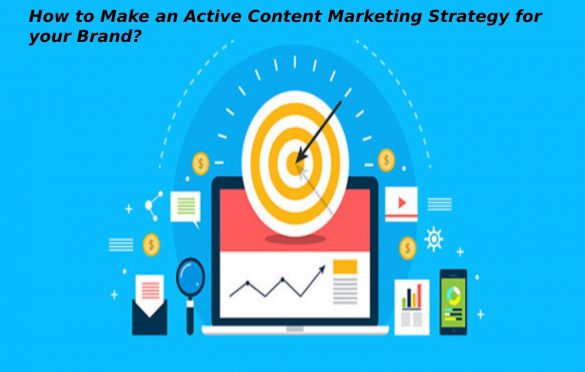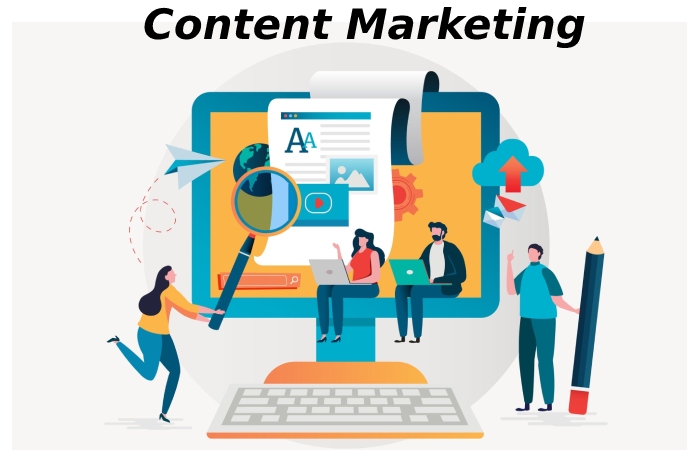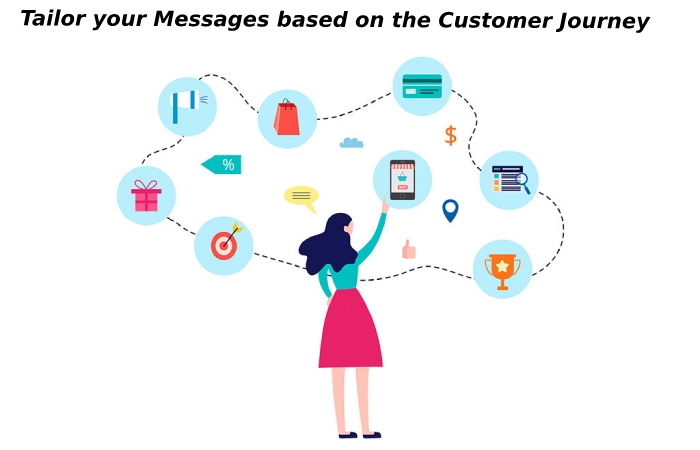
How to Make an Active Content Marketing Strategy for your Brand?
Table of Contents
Content Marketing Definition

Content marketing, this strategy refers to creating relevant and valuable content to meet the needs of your target market. Relevant and quality content can result in higher conversion and loyalty from prospects and customers and reinforce your brand image and positioning.
And also, it is based on disseminating messages in your communication channels: from the blog and social networks to the newsletter, commercial yearbooks, and local guides. And also, it has numerous advantages:
It allows you to optimize SEO positioning: By creating quality blog articles, you will improve your natural positioning in search engines and gain visibility when Internet users conduct specific searches (with keywords that correspond to your products, for example).
It allows you to enhance your brand image: You can create a solid and inspiring brand image by spreading your expert knowledge on your blog or social networks. In this way, potential clients will be convinced that you are an excellent choice to meet their goals.
It allows you to found a lasting relationship with your clients: Sharing quality content —for example, in your newsletter— is an opportunity to maintain contact with your clients and develop an effective lead-nurturing campaign.
It allows you to attract quality traffic: When you optimize your SEO and acquire more visibility on social networks when you create infographics that are easily shared (to name just a few examples), you can attract new prospects to your landing pages and generate more sales.
In a digital environment with ever-increasing competition, a good content strategy will often differentiate between an invisible company and one that performs well!
How to Make an Active Content Marketing Strategy for Your Brand?
Now we will see how to make an active content marketing strategy for your brand’s digital marketing plan and organize the dissemination in your different communication media.
1. Define your Goals
The first stage of a good content strategy is the precise definition of your objectives
The term “Content Strategy” may seem vague, and the truth is that it is because it is a set of numerous isolated strategies in which different company teams will be involved.
So, to guide your digital strategy, the first step is to define several performance indicators (KPIs) that will allow you to mount the success of your plan. These objectives could be, for example:
- Improve your SEO positioning and increase your visibility in search engines.
- Increase the interaction of your publications on social networks.
- Increase your website traffic.
- And also, increase the conversion rate associated with your newsletter.
- We recommend avoiding a list of objectives that is too long and focusing on a list of two or three goals to prevent losing the overview of your strategy.
To define your goals, it is always helpful to use the SMART method.
What is the Smart Method?
This is a method to identify targets and S cific, M encurables, A lcanzables, R ealistas, and T temporaries.
These qualities are interpreted as follows:
Specific: The objectives must be clearly defined, and you must also identify the resources you are going to assign to each of them (for example, the team members in charge of meeting them).
Measurable: Make sure you choose easily quantifiable performance indicators, for example, the increase in registrations to your newsletter or the variation in your website traffic that you can measure with tools such as Google Analytics.
Achievable: It is useless to define impossible goals – or almost – that cause stress to your team and make your strategy ineffective.
Realists: It comes from the English Relevant (proper) in the original acronym. It’s about setting goals that are going to be beneficial for your company. For example, it is useless to increase the subscriptions to your newsletter if you do not intend to carry out an emailing strategy.
Temporary: With a defined term. Always set a deadline for meeting your goals: it will help you evaluate the effectiveness of your campaigns in the future.
SMART objectives are an excellent way to acquire a global vision for the implementation of your editorial strategy.
To give you a more concrete idea, we are going to share two possible examples of SMART goals:
Increase organic website traffic by 25% in one year by publishing 4 blog articles per month
Gain 300 new contacts for the newsletter in 6 months thanks to regular Facebook and Twitter posts.
2. Identify your Customer Prototypes
To guide content creation with significant added value, the first thing you must do is identify your target audience.
On the Sendinblue blog, we often talk about buyer personas or buyer prototypes. And we have a good reason to do so: they are a starting point, often indispensable, for creating your marketing campaigns.
A buyer persona represents a typical consumer profile of your company. It will help you know your customers’ specific needs and expectations and respond to them in the best possible way.
To create your client prototypes, the usual thing is to rely on the following characteristics:
Demographics: age, gender, the city where your customers live, etc.
The professional profile of your clients: if they are CEOs and make decisions, employees specialized in marketing, freelance, etc. Often, this information will determine the time and energy they will be able to invest in your services.
Social characteristics: such as your income level, your family situation, your budget, etc.
Their behavior as consumers: the communication channels (email, social networks, etc.), their preferred devices (smartphone, tablet, desktop computer, etc.), their focuses of interest, and their consumption habits: do they often buy on the Internet? How much do they usually spend? And other related questions.
If you have a company that already has customers, the best way to define your consumer prototypes is to get to know your current audience; for example, by sending them surveys or organizing focus groups.
On the other hand, if your project takes its first steps, it will be more predictive. You will have to try to figure out what type of customers you will attract in the future.
3. Tailor your Messages based on the Customer Journey

To plan your content well, it is essential to organize it according to its function in the sales funnel.
What is the Sales Funnel?
The sales (or conversion) funnel is the journey formed by the different stages of interaction between a consumer and a company, from the first contact to the purchase decision.
At the top of the sales funnel, the primary objective is to give visibility to your brand. For example, showing up in a good position in search engines for a particular keyword. Then, you must awaken consumer interest by positioning yourself as an expert and earning their trust.
The additional you go down the funnel, the closer you get to selling. In the final phases, therefore, it is about stimulating the decision (with special offers, for example) and then finalizing the purchase with facilities that simplify the process for the consumer (free delivery, for example).
The Different Communication Formats for Your Content
Depending on the sales funnel stage in which the audience you target. You can use different communication formats to perform other functions in your content strategy.
These are the primary communication formats that you have at your disposal in the different stages of the sales funnel:
Blog articles: They are particularly effective in optimizing your SEO (your positioning in search engines). Therefore, they will be helpful to the visibility of your brand in the first stage of the sales funnel. In addition, blog articles will also be beneficial in the second stage, as they will allow you to consolidate your position as an expert and, at the same time, present your products and services.
Infographics: They are also convenient, especially in the first two stages of the funnel. They are easily communal on social networks and are an excellent way to improve your visibility.
Newsletters: A consumer who joins the mailing list to receive your newsletter already has a specific interest in your brand. Therefore, creating a newsletter is more effective in targeting prospects in the penultimate stage of the funnel. You can also take advantage of them to publicize new products, offer discounts, special offers, etc.
Landing Pages: The landing pages or landing pages/landing are a resource used in the final stage of the sales funnel: in them, they can offer calls for concrete action to buy a product, make an offer, etc.
Naturally, this distribution along the sales funnel depends on your strategy and objectives and must be adapted for each case. Apart from,
4. Create your Editorial Calendar and your Communication Plan
- Once your content strategy is defined, you can use tables to organize and outline it.
- For this, the editorial calendar and the communication plan are handy tools. They allow you to define your editorial line, and organize the types of content. And prepare the dissemination and production of the content.
- Although at first glance, they are relatively similar, they have slightly different functions.
The Editorial Calendar
- An editorial calendar is an instrument that will assist you in classifying your content and planning its preparation.
- It will allow you to organize your teams and define responsibilities. And deadlines to create your blog articles, infographics, newsletters, etc.
- It is usually prepared in an Excel table, although you can also use specific project management tools like Asana or Trello.
The Communication Plan
- The communication plan allows you to plan the dissemination of the content that your team has prepared.
- Here you can also indicate the team members responsible for each task, and the dissemination channels (newsletter, Twitter, LinkedIn, etc.). And also, the expected publication dates.
- It is also an excellent way to specify each dissemination action’s objective. And also, have a global vision of your company’s communication.
Conclusion
How to Make an Active Content Marketing Strategy for your brand is a way to include your target spectators and grow your network of leads and customers by creating relevant and valuable content, attracting, involving, and generating value for people, and creating a perception positive of your brand generating more business.
Also Read: Best Emulator To Play Clash Of Clans
Related Searches to How to Make an Active Content Marketing Strategy for your Brand?
[content marketing examples]
[content marketing pdf]
[types of content marketing]
[how to do content marketing]
[content marketing strategy]
[marketing content examples of companies]
[content marketing definition]
[content marketing for social networks]
[10 marketing strategies]
[5 marketing strategies]
[marketing strategies examples]
[What are the 4 strategies of marketing?]
[digital marketing strategies examples]
[strategies marketing mix examples]
[types of strategies marketing]
[Examples of strategies of successful companies]


